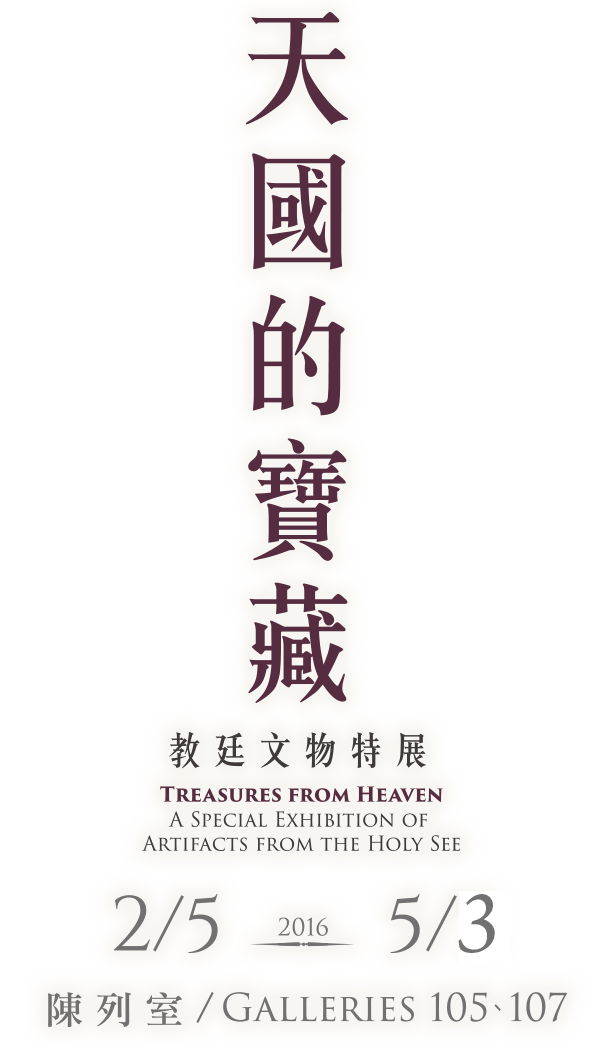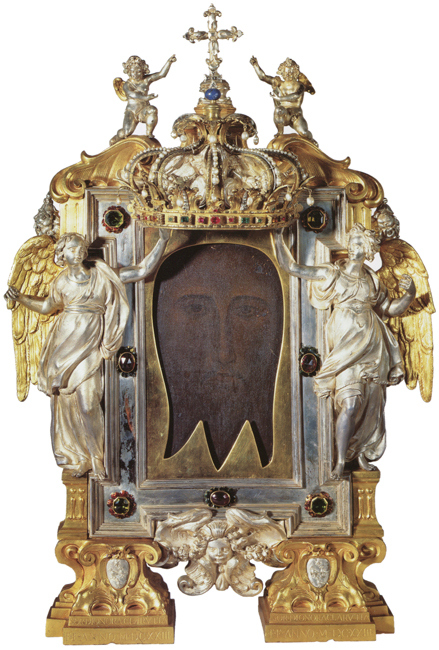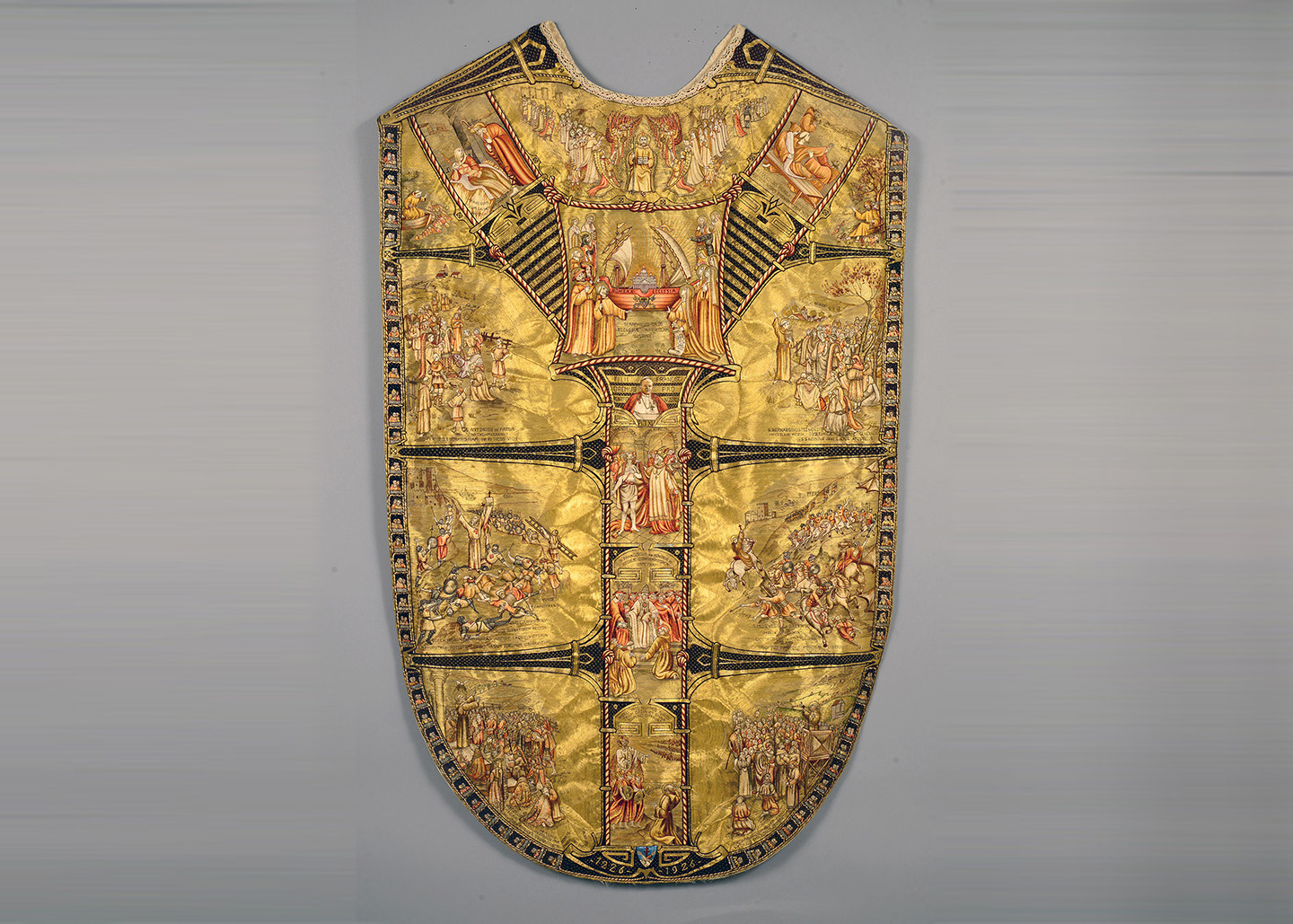Pope Francis, elected to the Papacy in 2013, has always emphasized harmony between Man and Nature. In the most recent encyclical entitled Laudato si' ("Praise Be to You"; May 24, 2015), Pope Francis discusses the problems related to ecology and expresses hope that people all over the world can follow the example of Saint Francis of Assisi (1181-1226). By seeing themselves as part and parcel of the universe that God created, people can thereby realize the importance attached by the Holy See to environmental problems facing the world today. At the same time, Pope Francis also announced that from 8 December 2015 (Feast of the Immaculate Conception) to 20 November 2016 (Feast of Christ the King) an "Extraordinary Jubilee" would be held and known as the "Jubilee of Mercy." At the start of the Jubilee on December 8, the Pope followed tradition and opened the Great Door at Saint Peter's Basilica to mark its beginning.
Mandylion of Edessa
- 3rd-5th century
- Francesco Comi for the frame (1623)
- Height: 65 cm, Width: 45 cm
- Collection of the Office for the Liturgical Celebrations of the Supreme Pontiff
The elaborate seventeenth-century mounting that frames and crowns the likeness of Christ's face provides a brilliant contrast to the dark, almost invisible portrait and, simultaneously, establishes its aspect as a relic within a reliquary. The painting seems to have been made as a replacement for a nearly identical icon in Genoa (San Bartolomeo degli Armeni),most likely when the latter was enclosed in its fourteenth century frame.
The Vatican and Genoa faces both replicate Byzantium's most venerated icon, the Mandylion, claimed to have been created when a painter dispatched to the Holy Land by King Abgar of Edessa (Urfa in modern Turkey) was unable to capture Christ's visage using traditional artistic means because of the radiance emanating from the divine face. Washing his face and drying it on a towel, the Lord effected the portrait's miraculous transfer onto the cloth. When the Mandylion was brought back to Edessa, it cured Abgar of leprosy, acting as if it were Christ himself, who had left actual relics behind when he ascended to heaven.
Continuing a tradition in which pilgrims captured the aura of relics by touching them with cloths (brandea), the Mandylion was then no ordinary painting. An acheiropoieton, that is, an image "not made by human hands," it hovered between being a picture and a touch-relic, an aspect captured by the portrait, which seems to be dyed into the cloth without clear contours except those made by the gold mat superimposed on it. Like a shadow, the Mandylion reminds viewers that Christ was once present and visible on earth but has returned to his Father, and, in so doing, it conjures up both the human Jesus and his ineffable divinity.
Although the Mandylion was believed to be capable of replicating itself when cloths or other substances were laid on top of it, the miraculously made image continued to attract pilgrims to Edessa until it was rescued from the Moslemcontrolled city by Emperor Constantine VII (r. 905-959) and installed with ten relics of Christ's Passion in the imperial palace in Constantinople. It was displayed in the Pharos Chapel with the tablets given to Moses on Mt. Sinai and once treasured in the Ark of the Covenant, which the tenth-century account of the Mandylion's transfer to as "the other, less elevated ark." Indeed, the Baroque angel-frame may have been intended to evoke the cherubim that watched over the great Jewish reliquary chest. In the medieval setting, the association with the tablet of the law containing a prohibition of images, the Mandylion realized the fundamental theological argument that God's covenant with the Jews, given in words, had been superseded by the incarnate Christ whose dual nature enabled both relics and images.
Reference: Martina Bagnoli and Holger Klein, et al., eds., Treasures of Heaven: Saints, Relics, and Devotion in Medieval Europe (New Haven and London: Yale University Press, 2012), pp. 198-199.
Aureate chasuble with stole and maniple of Pope Pius XI (r. 1922-1939)
- Made by Franciscan Sisters of the Poor Clare of the monastery of St. Clare of the Sacred Heart
- 1926, Mazamet, France
- Silk, gold thread
- Height: 105 cm, width: 45 cm
- Collection of the Office for the Liturgical Celebrations of the Supreme Pontiff
This vestment was offered to Pope Pius XI (1922-1939) by the Franciscan Order of Friars Minor and made by the Poor Clare of the Franciscan Monastery of St. Clare of the Sacred Heart in Mazamet (France) in 1926 for the 700th anniversary of the death of St. Francis of Assisi. The chasuble (with stole and maniple) is in gold brocade finely embroidered in gold thread and silk polychrome. It is divided into panels depicting scenes from the life of St. Francis, images of Pope Pius XI, scenes of missions, Maria Ss.ma between angels and saints, scenes of the Crusades, and a ship with the Basilica of St. Peter symbolizing the Church. All around, on both sides, are small portraits of Franciscan saints and martyrs. The opening of the neck has a simple lace. The stole and the maniple also have scenes of missions in the East (stole), in Europe and in the Middle East (maniple), and the edge has small portraits of saints and martyrs. They end with golden thread ribbon fringes.





